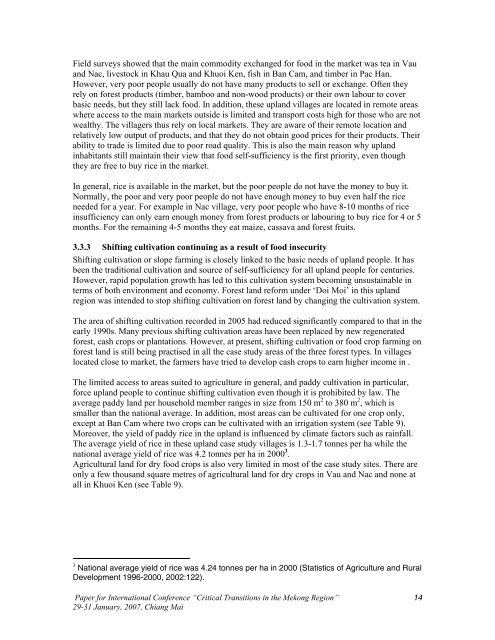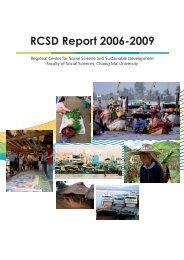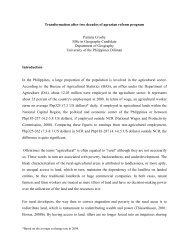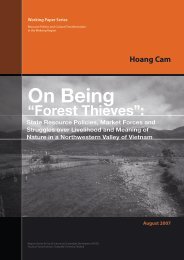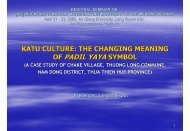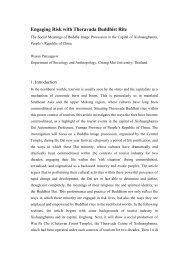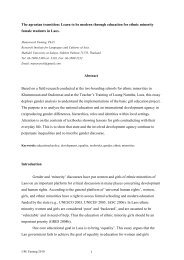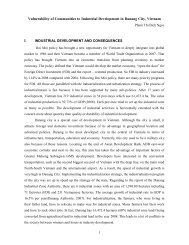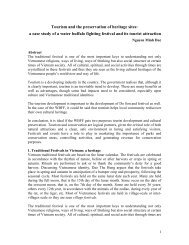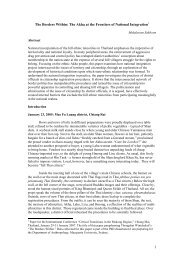The Impact of the Renovation Policies on the Livelihoods of ... - RCSD
The Impact of the Renovation Policies on the Livelihoods of ... - RCSD
The Impact of the Renovation Policies on the Livelihoods of ... - RCSD
Create successful ePaper yourself
Turn your PDF publications into a flip-book with our unique Google optimized e-Paper software.
Field surveys showed that <str<strong>on</strong>g>the</str<strong>on</strong>g> main commodity exchanged for food in <str<strong>on</strong>g>the</str<strong>on</strong>g> market was tea in Vauand Nac, livestock in Khau Qua and Khuoi Ken, fish in Ban Cam, and timber in Pac Han.However, very poor people usually do not have many products to sell or exchange. Often <str<strong>on</strong>g>the</str<strong>on</strong>g>yrely <strong>on</strong> forest products (timber, bamboo and n<strong>on</strong>-wood products) or <str<strong>on</strong>g>the</str<strong>on</strong>g>ir own labour to coverbasic needs, but <str<strong>on</strong>g>the</str<strong>on</strong>g>y still lack food. In additi<strong>on</strong>, <str<strong>on</strong>g>the</str<strong>on</strong>g>se upland villages are located in remote areaswhere access to <str<strong>on</strong>g>the</str<strong>on</strong>g> main markets outside is limited and transport costs high for those who are notwealthy. <str<strong>on</strong>g>The</str<strong>on</strong>g> villagers thus rely <strong>on</strong> local markets. <str<strong>on</strong>g>The</str<strong>on</strong>g>y are aware <str<strong>on</strong>g>of</str<strong>on</strong>g> <str<strong>on</strong>g>the</str<strong>on</strong>g>ir remote locati<strong>on</strong> andrelatively low output <str<strong>on</strong>g>of</str<strong>on</strong>g> products, and that <str<strong>on</strong>g>the</str<strong>on</strong>g>y do not obtain good prices for <str<strong>on</strong>g>the</str<strong>on</strong>g>ir products. <str<strong>on</strong>g>The</str<strong>on</strong>g>irability to trade is limited due to poor road quality. This is also <str<strong>on</strong>g>the</str<strong>on</strong>g> main reas<strong>on</strong> why uplandinhabitants still maintain <str<strong>on</strong>g>the</str<strong>on</strong>g>ir view that food self-sufficiency is <str<strong>on</strong>g>the</str<strong>on</strong>g> first priority, even though<str<strong>on</strong>g>the</str<strong>on</strong>g>y are free to buy rice in <str<strong>on</strong>g>the</str<strong>on</strong>g> market.In general, rice is available in <str<strong>on</strong>g>the</str<strong>on</strong>g> market, but <str<strong>on</strong>g>the</str<strong>on</strong>g> poor people do not have <str<strong>on</strong>g>the</str<strong>on</strong>g> m<strong>on</strong>ey to buy it.Normally, <str<strong>on</strong>g>the</str<strong>on</strong>g> poor and very poor people do not have enough m<strong>on</strong>ey to buy even half <str<strong>on</strong>g>the</str<strong>on</strong>g> riceneeded for a year. For example in Nac village, very poor people who have 8-10 m<strong>on</strong>ths <str<strong>on</strong>g>of</str<strong>on</strong>g> riceinsufficiency can <strong>on</strong>ly earn enough m<strong>on</strong>ey from forest products or labouring to buy rice for 4 or 5m<strong>on</strong>ths. For <str<strong>on</strong>g>the</str<strong>on</strong>g> remaining 4-5 m<strong>on</strong>ths <str<strong>on</strong>g>the</str<strong>on</strong>g>y eat maize, cassava and forest fruits.3.3.3 Shifting cultivati<strong>on</strong> c<strong>on</strong>tinuing as a result <str<strong>on</strong>g>of</str<strong>on</strong>g> food insecurityShifting cultivati<strong>on</strong> or slope farming is closely linked to <str<strong>on</strong>g>the</str<strong>on</strong>g> basic needs <str<strong>on</strong>g>of</str<strong>on</strong>g> upland people. It hasbeen <str<strong>on</strong>g>the</str<strong>on</strong>g> traditi<strong>on</strong>al cultivati<strong>on</strong> and source <str<strong>on</strong>g>of</str<strong>on</strong>g> self-sufficiency for all upland people for centuries.However, rapid populati<strong>on</strong> growth has led to this cultivati<strong>on</strong> system becoming unsustainable interms <str<strong>on</strong>g>of</str<strong>on</strong>g> both envir<strong>on</strong>ment and ec<strong>on</strong>omy. Forest land reform under ‘Doi Moi’ in this uplandregi<strong>on</strong> was intended to stop shifting cultivati<strong>on</strong> <strong>on</strong> forest land by changing <str<strong>on</strong>g>the</str<strong>on</strong>g> cultivati<strong>on</strong> system.<str<strong>on</strong>g>The</str<strong>on</strong>g> area <str<strong>on</strong>g>of</str<strong>on</strong>g> shifting cultivati<strong>on</strong> recorded in 2005 had reduced significantly compared to that in <str<strong>on</strong>g>the</str<strong>on</strong>g>early 1990s. Many previous shifting cultivati<strong>on</strong> areas have been replaced by new regeneratedforest, cash crops or plantati<strong>on</strong>s. However, at present, shifting cultivati<strong>on</strong> or food crop farming <strong>on</strong>forest land is still being practised in all <str<strong>on</strong>g>the</str<strong>on</strong>g> case study areas <str<strong>on</strong>g>of</str<strong>on</strong>g> <str<strong>on</strong>g>the</str<strong>on</strong>g> three forest types. In villageslocated close to market, <str<strong>on</strong>g>the</str<strong>on</strong>g> farmers have tried to develop cash crops to earn higher income in .<str<strong>on</strong>g>The</str<strong>on</strong>g> limited access to areas suited to agriculture in general, and paddy cultivati<strong>on</strong> in particular,force upland people to c<strong>on</strong>tinue shifting cultivati<strong>on</strong> even though it is prohibited by law. <str<strong>on</strong>g>The</str<strong>on</strong>g>average paddy land per household member ranges in size from 150 m 2 to 380 m 2 , which issmaller than <str<strong>on</strong>g>the</str<strong>on</strong>g> nati<strong>on</strong>al average. In additi<strong>on</strong>, most areas can be cultivated for <strong>on</strong>e crop <strong>on</strong>ly,except at Ban Cam where two crops can be cultivated with an irrigati<strong>on</strong> system (see Table 9).Moreover, <str<strong>on</strong>g>the</str<strong>on</strong>g> yield <str<strong>on</strong>g>of</str<strong>on</strong>g> paddy rice in <str<strong>on</strong>g>the</str<strong>on</strong>g> upland is influenced by climate factors such as rainfall.<str<strong>on</strong>g>The</str<strong>on</strong>g> average yield <str<strong>on</strong>g>of</str<strong>on</strong>g> rice in <str<strong>on</strong>g>the</str<strong>on</strong>g>se upland case study villages is 1.3-1.7 t<strong>on</strong>nes per ha while <str<strong>on</strong>g>the</str<strong>on</strong>g>nati<strong>on</strong>al average yield <str<strong>on</strong>g>of</str<strong>on</strong>g> rice was 4.2 t<strong>on</strong>nes per ha in 2000 3 .Agricultural land for dry food crops is also very limited in most <str<strong>on</strong>g>of</str<strong>on</strong>g> <str<strong>on</strong>g>the</str<strong>on</strong>g> case study sites. <str<strong>on</strong>g>The</str<strong>on</strong>g>re are<strong>on</strong>ly a few thousand square metres <str<strong>on</strong>g>of</str<strong>on</strong>g> agricultural land for dry crops in Vau and Nac and n<strong>on</strong>e atall in Khuoi Ken (see Table 9).3 Nati<strong>on</strong>al average yield <str<strong>on</strong>g>of</str<strong>on</strong>g> rice was 4.24 t<strong>on</strong>nes per ha in 2000 (Statistics <str<strong>on</strong>g>of</str<strong>on</strong>g> Agriculture and RuralDevelopment 1996-2000, 2002:122).Paper for Internati<strong>on</strong>al C<strong>on</strong>ference “Critical Transiti<strong>on</strong>s in <str<strong>on</strong>g>the</str<strong>on</strong>g> Mek<strong>on</strong>g Regi<strong>on</strong>”29-31 January, 2007, Chiang Mai14


